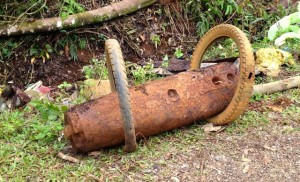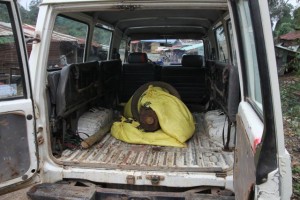Twenty-thousand killed or injured but millions live with fear.

This bomb lay under sheets of tin and a pile of rubbish for years outside a small village shop. The owner grabbed us when she recognized the first opportunity in years to get rid of the danger
A couple invested family funds to open a small shop and then, after they were committed to the location, discovered a bomb thirty feet from their door. From the moment of it’s discovery the bomb controlled their lives. Should they invest more funds in expanding their shop in that location? Should they warm customers about the danger of parking their motorbikes near the bomb? How closely should they monitor smokers who might discard a burning cigarette near the dried grass that hid the bomb from view?
They considered a warning sign but markers would only draw curiosity seekers or scrap collectors or inquisitive children whose tampering might endanger the village. Better, they decided, to cover the bomb with sheets of galvanized roofing material and pile trash on top of it. People in the village would know what lurked beneath the trash; passersby, and children born since the bomb’s discovery, would never explore the site.
I wasn’t in this village five minutes before the shopkeeper trotted up to me and insisted that I look at her bomb. (In a country where you can wait forty years for UXO removal, if you find a bomb, it’s YOUR BOMB. If you find a landmine, it’s YOUR LANDMINE.)
I asked the woman for her patience. Not hours, days, weeks, or months. But, time enough for our team to eat lunch after a morning’s labor in nearby fields. I suspect that she feared we would slip away but we were, after lunch, true to our word.
The bomb was right where the lady told us we’d find it and, it was close in size to what she remembered. (Close enough anyway. Understandably, the bomb in her mind was two feet longer than the bomb we found under the rubbish and tin. My hunch is that every time she witnessed a close call with that bomb, in her mind’s eye it grew an inch!)The site was too close to habitations for us to do much with it, and not wanting to leave it exposed for any length of time, we chose to transport it out of town for eventual destruction. You might well ask, “How do you transport bombs?” The joke is, we transport them like porcupines make love: very carefully.

